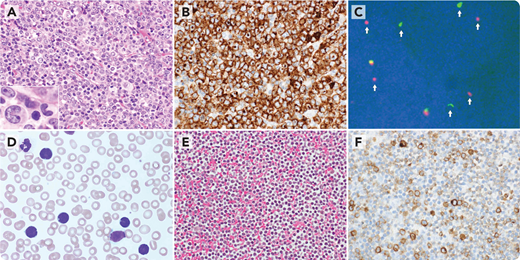A 58-year-old woman presented with generalized lymphadenopathy. The lymph node showed diffuse involvement of atypical lymphoid cells, including hallmark cells (panel A, hematoxylin and eosin, 40× objective, ×400 original magnification) that were homogenously positive for CD30 (panel B, 40× objective, ×400 original magnification) and CD3, and negative for CD4, CD5, CD7, CD8, CD15, CD20, ALK, TIA-1, and granzyme B. Fluorescence in situ hybridization identified the rearrangement of DUSP22 (panel C, arrow, 100× objective, ×1000 original magnification), diagnostic of anaplastic large cell lymphoma (ALCL), ALK-negative. Five months after complete remission was achieved with chemotherapy, the leukocyte count in the peripheral blood increased to 196 × 109/L, primarily composed of small to medium-sized lymphoid cells (panel D, 100× objective, ×1000 original magnification). Similar cells in a bone marrow aspiration clot (panel E, 40× objective, ×400 original magnification) showed variable positivity for CD30 (panel F, ×40 objective, ×400 total magnification), indicative of small-cell pattern of ALCL. These cells exhibited DUSP22 rearrangement and an identical TRG rearrangement with the primary lymph node lesion.
The small-cell pattern of ALCL has previously only been reported in an ALK-positive setting, characterized by frequent leukemic manifestation and poor prognosis. This is the first case of small-cell pattern of the DUSP22-rearranged ALCL and suggests an analogous relationship between DUSP22-rearranged and ALK-rearranged ALCL from a clinicopathological viewpoint.
A 58-year-old woman presented with generalized lymphadenopathy. The lymph node showed diffuse involvement of atypical lymphoid cells, including hallmark cells (panel A, hematoxylin and eosin, 40× objective, ×400 original magnification) that were homogenously positive for CD30 (panel B, 40× objective, ×400 original magnification) and CD3, and negative for CD4, CD5, CD7, CD8, CD15, CD20, ALK, TIA-1, and granzyme B. Fluorescence in situ hybridization identified the rearrangement of DUSP22 (panel C, arrow, 100× objective, ×1000 original magnification), diagnostic of anaplastic large cell lymphoma (ALCL), ALK-negative. Five months after complete remission was achieved with chemotherapy, the leukocyte count in the peripheral blood increased to 196 × 109/L, primarily composed of small to medium-sized lymphoid cells (panel D, 100× objective, ×1000 original magnification). Similar cells in a bone marrow aspiration clot (panel E, 40× objective, ×400 original magnification) showed variable positivity for CD30 (panel F, ×40 objective, ×400 total magnification), indicative of small-cell pattern of ALCL. These cells exhibited DUSP22 rearrangement and an identical TRG rearrangement with the primary lymph node lesion.
The small-cell pattern of ALCL has previously only been reported in an ALK-positive setting, characterized by frequent leukemic manifestation and poor prognosis. This is the first case of small-cell pattern of the DUSP22-rearranged ALCL and suggests an analogous relationship between DUSP22-rearranged and ALK-rearranged ALCL from a clinicopathological viewpoint.
For additional images, visit the ASH Image Bank, a reference and teaching tool that is continually updated with new atlas and case study images. For more information, visit http://imagebank.hematology.org.


This feature is available to Subscribers Only
Sign In or Create an Account Close Modal